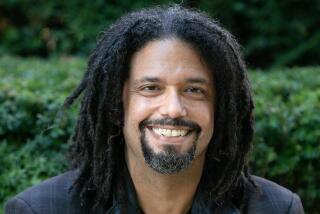BOOK REVIEW / NONFICTION : Supersonic Search for Meaning Stalls Airport Analogy : THE AIRPORT:Terminal Nights and Runway Days at John F. Kennedy International <i> by James </i> K<i> aplan</i> ; Morrow $23, 270 pages
- Share via
In the airport, journalist James Kaplan has landed upon a neat metaphor for postwar America. Just as great railway stations like Paris’ Gare de Lyon and Berlin’s Alexanderplatz mirrored the ebullience of late 19th-Century Europe, so America’s airports expressed its optimism in the 1950s.
JFK International (then Idlewild Airport) welcomed travelers with a rainbow-colored Fountain of Liberty and entertained them with silver-and-tablecloth restaurants before spiriting them off on graceful, silver-skinned planes.
Then came the signal year of 1973. In America, Watergate began doing to patriotism what the Weathermen had just done to idealism. At the airports, meanwhile, an Arab oil embargo tripled jet-fuel prices, forcing the airlines to cut back on most amenities. After the further blow struck by ‘80s deregulation, what had been a sweet and mysterious portal began to look like little more than another weary bus depot.
Noting the signs of malaise at JFK (and by implication, America), Kaplan watches Ernesto the custodian glumly pick up napkins and plastic spoons at JFK’s dismal Food Court (“Tuna Sandwiches: $6.95”). He listens to the bored Queens announcer warn incessantly about limo and baggage hustlers. And he wonders: “Where is the sunlight, grandeur, beauty, mystery, philanthropy, welcome and awe?”
Like director Godfrey Reggio, whose 1983 film “Koyaanisqatsi” depicted Manhattanites numbed, dazed and spiritually impoverished by the workaday routine, Kaplan believes that there was a time when life was lived with more emotional immediacy.
Early commercial air travel, he writes, where you “arrived at your destination weak, woozy, deaf and exhausted from hour upon 300-mile-per-hour hour in the air,” may not have been as comfy as today’s “hermetically sealed, sociologically alienating” flights, but it was more affecting: “You knew you were flying then!”
But whereas Reggio saw the frenetic pace of his Manhattan commuters as the tell-tale sign of “koyaanisqatsi” (Hopi for “life out of balance”), Kaplan sees speed as a kind of salvation.
Not surprisingly, then, Kaplan’s Holy Grail in these pages is to bum a ride on the Concorde. Anticipating the event, he projects a vision of speed that seems right out of the ‘50s, when Detroit was supercharging engines and Einstein was popularizing his theory that you could cheat time by zipping through space.
Kaplan eventually gets “to ride the rocket,” but since its speed of 1,350 miles per hour falls somewhat short of the minimum set by Einstein (186,000 miles per second ), it’s little surprise that he finds the trip “a profound anticlimax.”
Kaplan’s obsession with speed ends up disappointing us as well, for it leads him to set a frenetic narrative pace that deprives us of potentially engaging vignettes.
Sprinting down JFK’s labyrinthine corridors, Kaplan refuses to linger even when he lands upon infectiously exciting characters, such as the air traffic controller who compares “pushing tin” (moving planes) to “playing the World Series every night.” Kaplan clearly seems too invested in his generation’s hip nihilism to spin the kind of yarn his subjects sometimes require: the glitzy, sexy, narrative that Arthur Hailey pioneered with such books as “Airport” and “The Moneychangers.”
He’s also too arch to play the game of investigative reporter when that seems well-advised. When an airline captain suggests, for example, that pilot fatigue could be a serious problem on the new 747-400, which often carries 500 passengers on 14-hour trips with only two flight crew members, Kaplan never pursues the point.
What Kaplan, like many writers of his generation, does find hip is searching for the metaphysics of modern life. As he looks out of his airplane window at the beckoning lights of JFK’s runway, for instance, he quotes John Cardinal Newman: “Lead, kindly light, amid the encircling gloom; / lead thou me on!”
Such references ultimately seem more pretentious than profound, however, for they are sprinkled perfunctorily through these pages rather than woven into a story’s web. One suspects that Kaplan knows this, for when his narrative flags, he tries to jazz it up with the lurid details of--what else?--airplane crashes.
It works--our attention is restored. But not by reaching the new and transcendent literary heights that Kaplan aims for when this book first takes off.
More to Read
Sign up for our Book Club newsletter
Get the latest news, events and more from the Los Angeles Times Book Club, and help us get L.A. reading and talking.
You may occasionally receive promotional content from the Los Angeles Times.






